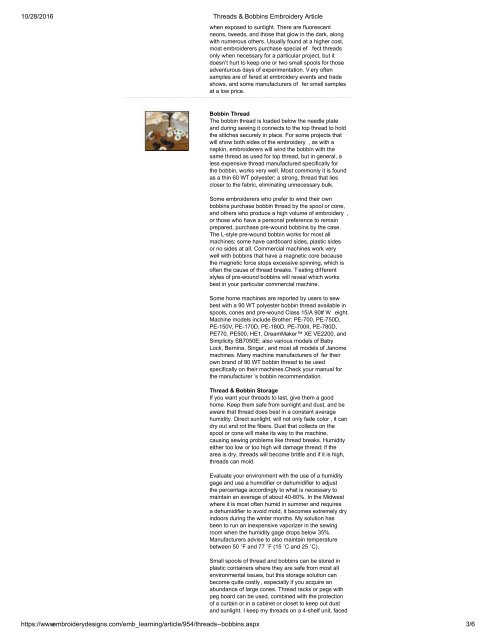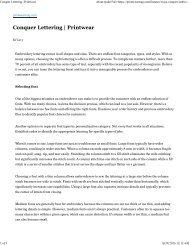Embroidery Basics Articles
Create successful ePaper yourself
Turn your PDF publications into a flip-book with our unique Google optimized e-Paper software.
10/28/2016 Threads & Bobbins <strong>Embroidery</strong> Article<br />
when exposed to sunlight. There are fluorescent<br />
neons, tweeds, and those that glow in the dark, along<br />
with numerous others. Usually found at a higher cost,<br />
most embroiderers purchase special ef fect threads<br />
only when necessary for a particular project, but it<br />
doesn’t hurt to keep one or two small spools for those<br />
adventurous days of experimentation. V ery often<br />
samples are of fered at embroidery events and trade<br />
shows, and some manufacturers of fer small samples<br />
at a low price.<br />
Bobbin Thread<br />
The bobbin thread is loaded below the needle plate<br />
and during sewing it connects to the top thread to hold<br />
the stitches securely in place. For some projects that<br />
will show both sides of the embroidery , as with a<br />
napkin, embroiderers will wind the bobbin with the<br />
same thread as used for top thread, but in general, a<br />
less expensive thread manufactured specifically for<br />
the bobbin, works very well. Most commonly it is found<br />
as a thin 60 WT polyester; a strong, thread that lies<br />
closer to the fabric, eliminating unnecessary bulk.<br />
Some embroiderers who prefer to wind their own<br />
bobbins purchase bobbin thread by the spool or cone,<br />
and others who produce a high volume of embroidery ,<br />
or those who have a personal preference to remain<br />
prepared, purchase prewound bobbins by the case.<br />
The Lstyle prewound bobbin works for most all<br />
machines; some have cardboard sides, plastic sides<br />
or no sides at all. Commercial machines work very<br />
well with bobbins that have a magnetic core because<br />
the magnetic force stops excessive spinning, which is<br />
often the cause of thread breaks. T esting dif ferent<br />
styles of prewound bobbins will reveal which works<br />
best in your particular commercial machine.<br />
Some home machines are reported by users to sew<br />
best with a 90 WT polyester bobbin thread available in<br />
spools, cones and prewound Class 15/A 90# W eight.<br />
Machine models include Brother: PE700, PE750D,<br />
PE150V, PE170D, PE180D, PE700II, PE780D,<br />
PE770, PE500, HE1, DreamMaker XE VE2200, and<br />
Simplicity SB7050E; also various models of Baby<br />
Lock, Bernina, Singer , and most all models of Janome<br />
machines. Many machine manufacturers of fer their<br />
own brand of 90 WT bobbin thread to be used<br />
specifically on their machines.Check your manual for<br />
the manufacturer ’s bobbin recommendation.<br />
Thread & Bobbin Storage<br />
If you want your threads to last, give them a good<br />
home. Keep them safe from sunlight and dust, and be<br />
aware that thread does best in a constant average<br />
humidity. Direct sunlight, will not only fade color , it can<br />
dry out and rot the fibers. Dust that collects on the<br />
spool or cone will make its way to the machine,<br />
causing sewing problems like thread breaks. Humidity<br />
either too low or too high will damage thread; if the<br />
area is dry, threads will become brittle and if it is high,<br />
threads can mold.<br />
Evaluate your environment with the use of a humidity<br />
gage and use a humidifier or dehumidifier to adjust<br />
the percentage accordingly to what is necessary to<br />
maintain an average of about 4060%. In the Midwest<br />
where it is most often humid in summer and requires<br />
a dehumidifier to avoid mold, it becomes extremely dry<br />
indoors during the winter months. My solution has<br />
been to run an inexpensive vaporizer in the sewing<br />
room when the humidity gage drops below 35%.<br />
Manufacturers advise to also maintain temperature<br />
between 50 ˚F and 77 ˚F (15 ˚C and 25 ˚C).<br />
Small spools of thread and bobbins can be stored in<br />
plastic containers where they are safe from most all<br />
environmental issues, but this storage solution can<br />
become quite costly , especially if you acquire an<br />
abundance of large cones. Thread racks or pegs with<br />
peg board can be used, combined with the protection<br />
of a curtain or in a cabinet or closet to keep out dust<br />
and sunlight. I keep my threads on a 4shelf unit, faced<br />
https://www.embroiderydesigns.com/emb_learning/article/954/threadsbobbins.aspx 3/6




